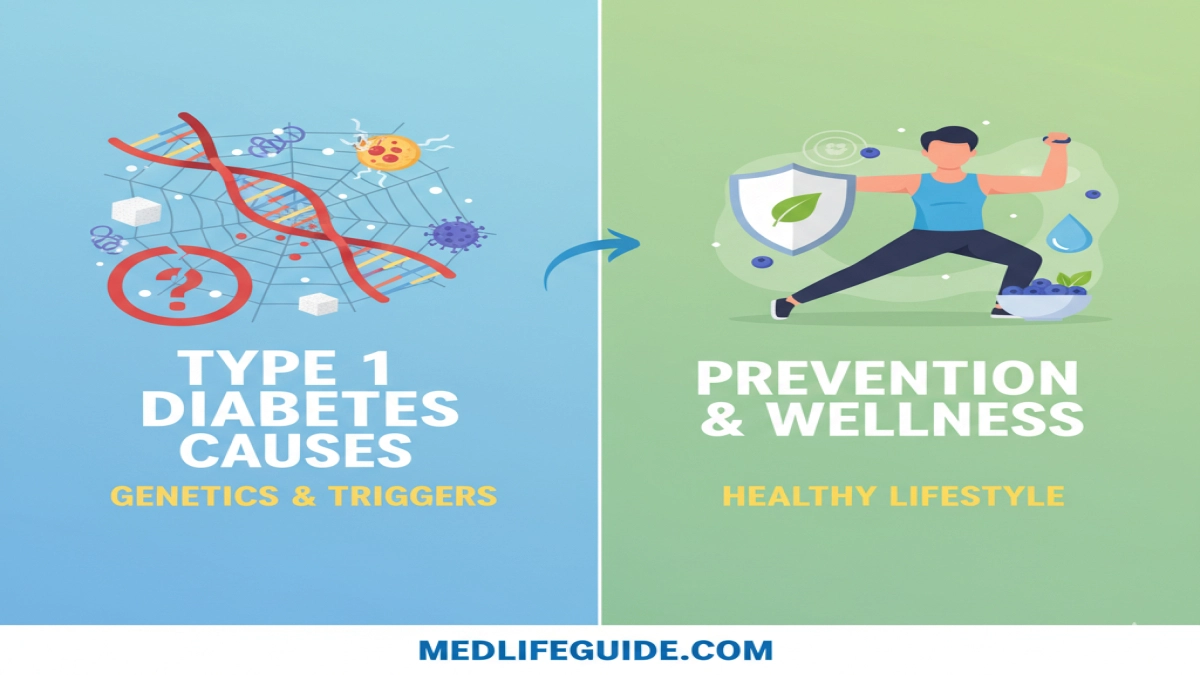Medically Reviewed and Compiled by Dr. [Adam N. Khan], MD.
Quick summary
Type 1 diabetes is an autoimmune disease in which the body destroys its own insulin-producing pancreatic beta cells. Genetics set the stage, but environmental triggers — infections, gut microbiome changes, and possibly early-life exposures — start the process in susceptible people. There is no proven way to prevent most cases today, but immune-targeting therapies can delay clinical onset in at-risk people and active research is narrowing real prevention options. Early detection of autoantibodies and enrollment in prevention trials is the current practical path for high-risk patients.
What is type 1 diabetes?
Type 1 diabetes (T1D) is a chronic autoimmune condition. The immune system attacks and destroys pancreatic beta cells that make insulin. Without insulin, the body cannot move glucose from the blood into cells, causing high blood sugar and, if untreated, life-threatening complications. Onset is often in childhood or young adulthood but can happen at any age. Management requires lifelong insulin replacement and regular monitoring.
How T1D develops: pathogenesis in plain terms
- Genetic susceptibility. Certain HLA gene variants, especially HLA-DR3 and HLA-DR4 and their combinations, raise risk. HLA explains a large portion of inherited risk, but many other genes contribute. Identical twins show less than 100% concordance, which proves environment matters too.
- Autoimmunity begins. For reasons we do not fully understand, the immune system begins making antibodies and T cells that target beta-cell proteins (GAD65, insulin, IA-2, ZnT8). Detectable autoantibodies mark the earliest measurable phase.
- Environmental triggers. Viral infections (enteroviruses like coxsackie B), gut microbiome shifts, early-life diet, and other exposures can trigger or accelerate autoimmune attack in genetically susceptible people. Evidence is strongest for enteroviruses, but causation is complex and not universal.
- Beta-cell loss and clinical diabetes. Once enough beta cells are destroyed, the body can no longer produce enough insulin and symptoms appear: excessive thirst, frequent urination, weight loss, fatigue, and sometimes diabetic ketoacidosis. Clinical diagnosis occurs at this stage unless detected earlier by screening.
Causes and risk factors — grouped and explained
Genetic factors
- HLA region. The strongest single genetic effect. HLA-DR and DQ haplotypes explain much inherited risk.
- Non-HLA genes. Variants in INS, PTPN22, CTLA4, and many others modify risk and immune response. Together they shape how aggressive autoimmunity will be.
Immune system factors
- Autoantibodies. Presence of two or more diabetes-related autoantibodies predicts high risk of progression to clinical disease. TrialNet and other programs use these markers to stage disease and offer monitoring.
Environmental and developmental factors
- Viral infections. Repeated evidence links enteroviruses to increased risk of islet autoimmunity and T1D. The relationship is likely facilitative not determinative in most cases.
- Microbiome and gut health. Early-life antibiotic use, cesarean delivery, and diet can alter microbiome development — emerging data show associations with autoimmunity risk. The field is active but not settled.
- Dietary exposures. Early introduction of complex foods, breastfeeding duration, and cow’s milk exposure have been studied. No single dietary factor has proven to be a reliable cause or protective intervention for most people.
Other associations
- Geography and seasonality. Incidence varies by country and season, implicating environmental triggers.
- Family history. First-degree relatives of people with T1D have higher risk, and families with multiple affected members have greater genetic load.
Preventing type 1 diabetes — what works, what’s promising, and what doesn’t
Current reality: no guaranteed primary prevention
At present there is no established, widely recommended way to prevent most cases of type 1 diabetes in the general population. Public health measures that lower type 2 diabetes risk (healthy diet, exercise, avoiding tobacco) do not prevent autoimmune type 1. Screening and early intervention in high-risk individuals is the practical strategy today.
Secondary prevention — delaying or preventing clinical onset in people already showing autoimmunity
- Teplizumab (Tzield). This anti-CD3 monoclonal antibody has been shown to delay progression from stage 2 (autoimmunity with dysglycemia) to stage 3 (clinical diabetes). The FDA approved teplizumab to delay onset in at-risk people aged 8 and older. This is the first drug to meaningfully alter disease trajectory in at-risk individuals. It is not a cure but a delay strategy, and access is generally through specialist centers.
- Oral insulin and other antigen-based approaches. Trials like DPT-1 and subsequent TrialNet studies tested antigen exposure (oral or intranasal insulin) to induce immune tolerance. Results are mixed; some subgroups may benefit, but oral insulin is not a general prevention approved for routine use. Ongoing research is refining who might respond.
- Immune modulation trials. Multiple immune therapies (anti-CD20, anti-IL agents, antigen-specific vaccines) are in clinical trials. Some early-phase studies show promise for preserving beta-cell function when started near diagnosis or in at-risk people. None except teplizumab has broad regulatory approval for prevention as of the latest trials.
Primary prevention research (aiming to stop autoimmunity before it starts)
- Research focuses on vaccines against enteroviruses, microbiome modulation, early dietary interventions, and maternal/early-life exposures. These are experimental and not yet validated for routine practice. Large, long trials are required because most genetically susceptible people do not develop T1D even with exposure.
Who should be screened and how
- First-degree relatives. Screening for islet autoantibodies can identify people at high risk. TrialNet offers testing and follow-up for relatives of people with T1D. Early detection allows eligibility for prevention trials and closer monitoring to prevent diabetic ketoacidosis at diagnosis.
- Clinical indications. Children or adults with symptoms or with another autoimmune disease may be tested for autoantibodies and blood glucose. If multiple autoantibodies are present, the risk of progression is high.
Practical prevention advice for families and clinicians (what to do now)
- If you have a family history, get tested for autoantibodies through TrialNet or your specialist. Knowing risk changes management and offers trial options.
- Protect against preventable infections. Good infection control and routine vaccinations are sensible; enterovirus vaccines are investigational but infection prevention has general health benefits.
- Avoid false promises. Be skeptical of unproven “preventive” diets or supplements marketed to stop type 1 diabetes. Discuss any such interventions with an endocrinologist.
- Enroll in research. For those at higher risk, clinical trials are where real prevention advances are happening. Specialist centers and TrialNet list current trials.
Unique Clinical Takeaways
These are advanced, practical perspectives clinicians and informed families should know — not the basic symptom list.
- Autoantibody profile and order predict timing and phenotype.
The number and type of autoantibodies (for example, insulin autoantibodies early in young children vs GAD antibodies common in adults) predict both the speed of progression and the likely clinical course. Clinicians should use the specific autoantibody pattern to tailor monitoring frequency and to counsel patients about expected timing. In practice this means testing for the full panel (GAD65, IAA, IA-2, ZnT8) rather than a single marker, because a single positive antibody confers lower short-term risk than multiple positives. - Teplizumab is a window, not a cure — plan follow-up and second-line strategies.
When teplizumab delays clinical onset, the delay can be years. But disease progression often resumes later. Clinicians should plan for ongoing surveillance, re-evaluate beta-cell function, and prepare families for eventual insulin therapy while using the delay to optimize education, technology access (CGM), and DKA prevention strategies. The drug’s benefit is highest when given at Stage 2; identifying candidates requires proactive screening. - Enteroviral links suggest targeted public health routes — but expect heterogeneity.
Population signals link enteroviruses to increased T1D risk. This implies that, in communities where enteroviral outbreaks are common, targeted efforts (surveillance, infection control, and eventual vaccines) could change incidence locally. However, heterogeneity in genetic risk and timing means such an approach would work for a subset only. Clinicians should consider recent infection history when evaluating new autoimmunity or rapid progression. - Beta-cell stress modifies risk and progression speed.
Episodes of metabolic stress (severe illness, rapid weight gain, or medications that affect metabolism) may accelerate beta-cell failure in someone already autoantibody positive. So prevention strategies should include minimizing avoidable metabolic stressors and early endocrine review during intercurrent illness in high-risk people. This subtle point often changes outcomes by preventing rapid progression to diabetic ketoacidosis. - Tailored genetic counseling for families — not deterministic advice.
Genetic testing can quantify risk but does not predict certainty. Counseling should emphasize probabilities, the role of environment, and available surveillance and trial options. This reduces anxiety and promotes informed participation in monitoring.
Diagnosis and staging (brief)
- Stage 1: Two or more islet autoantibodies, normal glucose tolerance, no symptoms.
- Stage 2: Autoantibodies plus abnormal glucose tolerance or dysglycemia, still pre-symptomatic.
- Stage 3: Clinical diabetes with hyperglycemia and symptoms.
Staging guides treatment and eligibility for prevention trials and immunotherapies.
Clinical management highlights (once diagnosis occurs)
- Immediate insulin replacement. Essential for survival in most cases.
- Education and technology. Early introduction of continuous glucose monitoring and structured education lowers complications.
- Monitor for other autoimmune diseases. People with T1D have higher risk of thyroid disease, celiac disease, and others; screen as appropriate.
What research should patients and clinicians watch
- Trials of enterovirus vaccines and antiviral strategies.
- New immune therapies for secondary prevention and for preserving beta-cell function after diagnosis.
- Microbiome-targeted interventions in infancy.
References and Citations
(Authoritative sources used in this article)
- StatPearls. “Type 1 Diabetes.” National Library of Medicine / NCBI Bookshelf. NCBI
- Ramos EL et al. “Teplizumab and β-Cell Function in Newly Diagnosed Type 1 Diabetes.” New England Journal of Medicine. New England Journal of Medicine
- TrialNet. “Oral Insulin Prevention Study & TrialNet resources.” TrialNet (Type 1 Diabetes TrialNet). trialnet.org
- Isaacs SR et al. “Enteroviruses and risk of islet autoimmunity or type 1 diabetes: systematic review and meta-analysis.” The Lancet Diabetes & Endocrinology. The Lancet
- Redondo MJ et al. “Genetics of Type 1 Diabetes.” NCBI Bookshelf / Genetics review. NCBI
- Centers for Disease Control and Prevention. “About Type 1 Diabetes.” CDC. CDC
- Cleveland Clinic. “Type 1 Diabetes: What It Is, Causes, Symptoms & Treatment.” Cleveland Clinic patient education. Cleveland Clinic
Standard medical disclaimer
This article is for informational purposes only and does not replace medical advice, diagnosis, or treatment from a qualified healthcare provider. If you suspect you or a loved one may have type 1 diabetes, contact your physician or local emergency services immediately. Outcomes depend on individual circumstances. Clinical recommendations and approvals change over time; consult current clinical guidelines and your specialist for decisions about testing, prevention trials, or medications.

